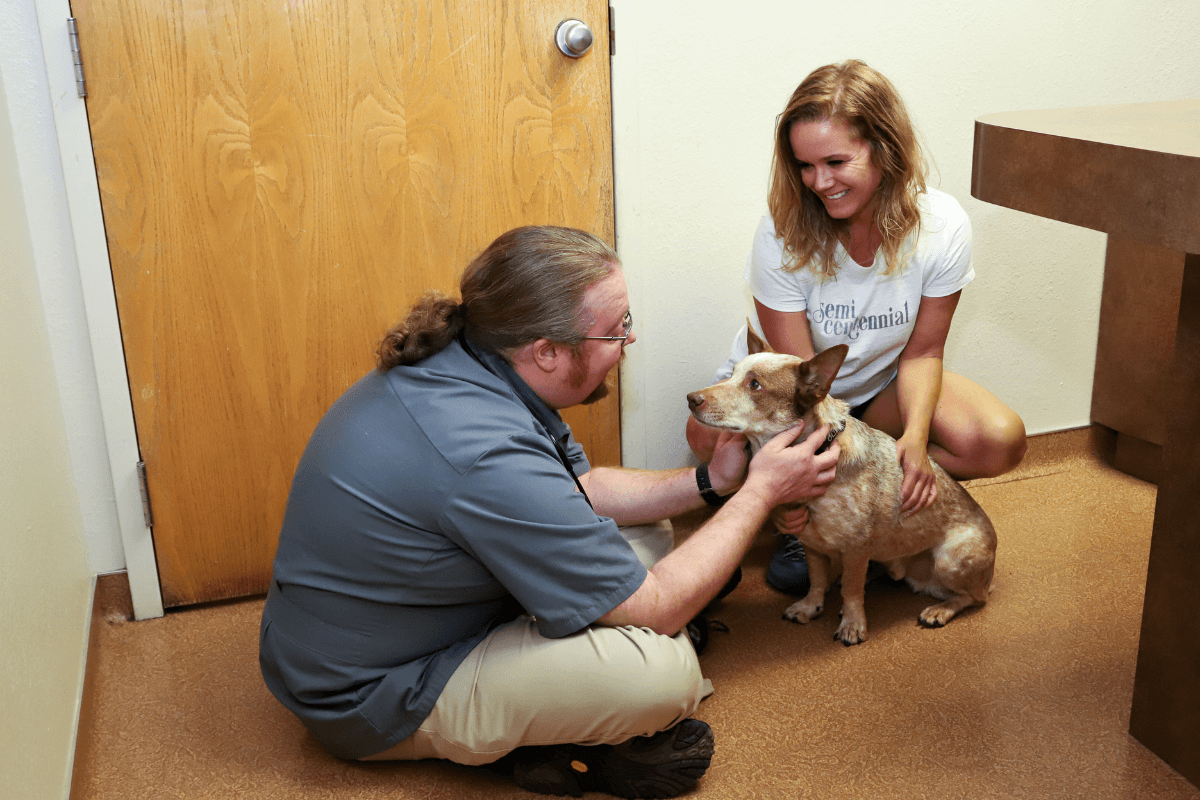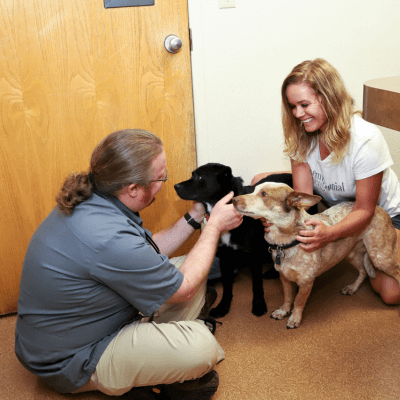Pet Alternative & Rehabilitative Medicine
Veterinary rehabilitation uses non-invasive manual techniques and non-pharmaceutical modalities to alleviate pain and inflammation, speed healing and return to function, and prevent future/further injury in your pet.

What is Veterinary Rehabilitation Therapy?
Rehabilitation is an essential component of recovery from orthopedic surgery and can ensure your pet has the best possible outcome. Rehabilitation can also be extremely beneficial as we support our beloved adult pets entering their geriatric years and experiencing the normal discomfort and anxiety that can often play a role in this stage of their life.
How is a Rehabilitation Assessment Different From a Regular Veterinary Visit?
The initial visit involves an hour-long, thorough orthopedic and neurologic exam followed by developing a rehabilitation plan carried out by our certified canine rehabilitation nurse.
The goal of this first visit is to identify or diagnose a list of specific problems or impairments that have led to functional limitations in your animal companion affecting their everyday life (e.g., Why can’t my companion jump into the car anymore? Why do they avoid the stairs? Why don’t they sit in their favorite chair any more?). We will discuss your companion’s lifestyle, home environment, and concurrent medical history in detail. Be prepared to be involved in creating and implementing a dynamic, multi-modal treatment plan. Together, we will create functional goals for your companion and learn how you can support and enhance their recovery by following an at-home exercise plan created specifically for your pet. For more details, visit our Colorado Springs Veterinary Surgery & Rehabilitation Center.
What is a Multi-Modal Treatment Plan?
The term “modalities” refers to a collection of techniques and treatments used by veterinary rehabilitation therapists to alleviate pain and inflammation and speed healing without using (or in conjunction with) traditional pharmaceutical therapies, such as pain medications. Any techniques or modality we choose to employ at Westside Animal Hospital has been vigorously researched so that we feel confident it will benefit your pet and help them enjoy the highest quality of life possible.
What Multi-Modal Treatment Options are Currently Available at Westside Animal Hospital?
Therapeutic Laser (Low-Level Light Therapy/LLLT) – Energy from the laser is absorbed by exposed cells, causing them to release a variety of helpful molecules that promote healing and decrease pain and inflammation.
Pulsed Electromagnetic Field Therapy (PEMF) – This therapy uses electricity to stimulate the cellular release of molecules that play essential roles in decreasing pain, improving blood flow, and decreasing edema. Additionally, PEMF therapy supports new blood vessel formation, tissue regeneration, and tissue remodeling, all essential to the overall healing process.
Neuromuscular Electrical Stimulation (NMES) – Electrical stimulation of muscle spindles can be used to increase muscle strength and mass and to improve functional muscle use. It can also be used to counteract various forms of muscle atrophy commonly seen in pets with neurologic and orthopedic injuries.
Manual Therapy – Manual therapy techniques for pets are specifically designed to assist the body’s own repair and adaptation processes, which, left on their own, will naturally tend toward dysfunctional adaptations, e.g., adaptations from an ACL tear will eventually lead to muscle wasting and dysfunctional motor control of the knee. Manual therapy techniques are designed to redirect these dysfunctional motor patterns to functional ones.
Therapeutic Exercises – The goals continue to be to treat pain, rebuild strength, and encourage functional motor patterns. You will be taught a variety of exercises designed to support and extend the benefits of the rehabilitation therapy for your pet.
Platelet Rich Plasma (PRP) – Blood is made up of several components that all have different jobs. The primary job of the platelets is to develop clots, but they also play an essential role in recruiting other cells from all over the body to stimulate healing. PRP therapy involves injecting a special mixture of your pet’s own platelets and other blood components into a diseased or arthritic joint to stimulate the body to heal itself. Eighty percent of patients will see marked improvement with a single injection, and in most cases, the entire procedure will take less than an hour. The benefits usually last between 6-9 months.
Stem Cell Therapy – Stem cell therapy (usually done in conjunction with PRP) involves taking special cells collected from your pet’s bone marrow or fat tissue (we use bone marrow-derived stem cells at Westside Animal Hospital) and injecting them into a diseased joint. While PRP therapy is aimed primarily at recruiting your dog’s cells to the site of damage to promote healing, stem cells create a scaffold for healing, break down scar tissue, stimulate new blood vessel development, and heal damaged tissue. This procedure is more costly and involved than PRP therapy alone, but the entire procedure can still be performed in as little as a few hours. The benefits can last up to a year or more in some patients.
Therapeutic Pet Laser and Uses
Explore the benefits of therapeutic pet laser therapy, a non-invasive option for pain and inflammation reduction. Successful in treating various conditions, including allergies, arthritis, wounds, and more, this advanced technology offers a soothing experience for your pet. Your pet will feel a warm, gentle sensation during laser therapy treatment administered through a handheld wand.
What to Expect During Laser Therapy
Laser therapy sessions are tailored to your pet’s condition, and the number and duration of treatments vary. Expect a personalized treatment plan discussed thoroughly before each session. Laser therapy can be a stand-alone option or complement other treatment plans. Contact us to schedule your pet’s laser therapy evaluation, providing a non-invasive, drug-free pain management solution. We are here to address any questions about the procedure or the therapeutic laser.

